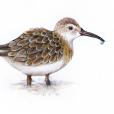Students learn about life in the ocean and the features and behaviours needed for living near the surface and in the deep sea. The properties of seawater are also considered, as well as human impacts. Incorporates an enjoyable playground game and choice of hands-on STEM activity.
An opportunity to take an unforgettable journey and explore ANSTO science virtually at the atomic scale for National #scienceweek
ANSTO has the capability to analyse heavy isotopes such as 129I, platinum group elements, 236U and Pu isotopes.
Emu instrument Scientist Gail Iles has left the Australian Centre for Neutron Scattering for RMIT.
In this half-day incursion, we uncover the surprising science of the Moon and look at past and future lunar missions. Students are guided through two hands-on STEM activities and celebrate the 50th anniversary of the first moon landing.
Students are introduced to shorebirds and their wetland habitats. They encounter the incredible journeys of our migratory shorebirds and how they connect wetlands in a fun playground game. Students also participate in a hands-on adaptations activity and learn about environmental research conducted at ANSTO.
The Shorebirds competition aims to raise awareness of the plight of endangered shorebirds and local habitat that are important for shorebirds and other organisms.
Ion beam analysis techniques can be used for trace element analysis and the surface characterisation of diverse materials.
ANSTO offers capabilities and expertise for the radiation testing and accreditation of space-based systems.
As blood breaks down in the skin tissue, the colour of a bruise changes with time. As such, it may be used to find out information about the age of the bruise and hence a timeframe of when the incident that caused the mark took place.
The Centre for Accelerator Science welcomes collaborations with industry for the development of new technologies,
Monash University, University of Queensland and Australian National University researchers have used ANSTO’s Australian Synchrotron in their study of meteorites found on Earth that could be used in future to find evidence of life on the planet Mars.
Scientists at ANSTO together with Lithium Australia Limited (LIT) have developed a world-first technology to extract more lithium from lithium mining waste, in a game-changer for Australian lithium industry.
Accurate ‘fingerprinting’ tool to verify source of origin is in development with collaborators from academia and industry.
Pagination











